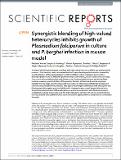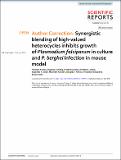| dc.contributor.author | 46. Kumar, P., Achieng, A. O., Rajendran, V., Ghosh, P. C., Singh, B. K., Rawat, M., Perkins, D. J., Kempaiah, P., & Rathi | |
| dc.date.accessioned | 2022-01-28T07:43:03Z | |
| dc.date.available | 2022-01-28T07:43:03Z | |
| dc.date.issued | 2017 | |
| dc.identifier.uri | https://repository.maseno.ac.ke/handle/123456789/4717 | |
| dc.description.abstract | A series of phthalimide analogues, novelized with high-valued bioactive scaffolds was synthesized by means of click-chemistry under non-conventional microwave heating and evaluated as noteworthy growth inhibitors of Plasmodium falciparum (3D7 and W2) in culture. Analogues 6a, 6h and 6 u showed highest activity to inhibit the growth of the parasite with IC50 values in submicromolar range. Structure-activity correlation indicated the necessity of unsubstituted triazoles and leucine linker to obtain maximal growth inhibition of the parasite. Notably, phthalimide 6a and 6u selectively inhibited the ring-stage growth and parasite maturation. On other hand, phthalimide 6h displayed selective schizonticidal activity. Besides, they displayed synergistic interactions with chloroquine and dihydroartemisinin against parasite. Additional in vivo experiments using P. berghei infected mice showed that administration of 6h and 6u alone, as well as in combination with dihydroartemisinin, substantially reduced the parasite load. The high antimalarial activity of 6h and 6u, coupled with low toxicity advocate their potential role as novel antimalarial agents, either as standalone or combination therapies | en_US |
| dc.publisher | Scientific Reports | en_US |
| dc.title | Synergistic blending of high-valued heterocycles inhibits growth of Plasmodium falciparum in culture and P. berghei infection in mouse model | en_US |
| dc.type | Article | en_US |


